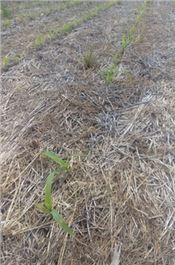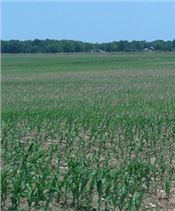Watch For Seedling Diseases In Corn
DR. KIERSTEN WISE
PRINCETON, KY.
Weather this spring has challenged corn farmers in Kentucky. Temperature swings and frequent rainfall have led to a wide range of corn growth stages, with some corn in early vegetative stages and some corn still in the bag. The cool, wet conditions that have plagued planting progress recently have also increased the risk of seedling disease in Kentucky corn fields.
Seedling diseases are caused by several soil or seed-inhabiting fungi or fungal-like organisms which are favored by cool, wet soil conditions during and after planting. Cool, wet soils also slow plant growth and development and give pathogens more time to infect and damage the seedling. Standard corn fungicide seed treatments provide a short window of protection against seedling diseases. However, corn that was planted several weeks ago may also be at increased risk of seedling disease, since seed treatments typically protect seeds and seedlings only for a few weeks. Two of the most common seedling diseases of corn in Kentucky are caused by Pythium and Fusarium species, but other fungi can occasionally cause seed and seedling issues.
Symptoms of seedling diseases can be observed after emergence and in the early vegetative stages of growth. Farmers should look for areas in the field with poor emergence, patchy stands, and/or stunted plants (Figure 1). Often these symptoms are observed first in poorly drained or ponded areas of the field, and areas with heavy or compacted soils. Infected seeds may rot after germination, preventing emergence and leading to the patchy appearance of plants in a field. Infected plants that do emerge may be yellow, stunted, and have discolored roots. In severe cases, large areas of plants may die leading to reduced stand (Figure 2). It is very difficult to accurately determine the specific organism responsible for a suspected seedling disease issue in the field. Submitting samples through a County Agent to the University of Kentucky Plant Disease Diagnostic Laboratory can help with obtaining an accurate diagnosis.
The risk of corn seedling disease decreases when corn is planted into dry soils with soil temperatures above 50 F. These conditions allow seeds and seedlings to germinate and emerge rapidly. However, it is often necessary to plant into less than ideal soil conditions, and diagnosing seedling disease issues if they occur can improve management in future years. Obtaining an accurate diagnosis is important because fungicide active ingredients work against specific organisms, and efficacy of a given product can vary for seedling blight organisms. Higher rates of specific products may be needed in fields that have a history of severe loss due to a specific seedling disease. ∆
DR. KIERSTEN WISE: Extension Plant Pathologist, University of Kentucky

Figure 1. Corn plants affected by seedling disease may have poor emergence within a row or an area in the field.
Photo: Kiersten Wise, University of Kentucky
 Figure 2. Severe stand reduction due to seedling disease.
Figure 2. Severe stand reduction due to seedling disease.